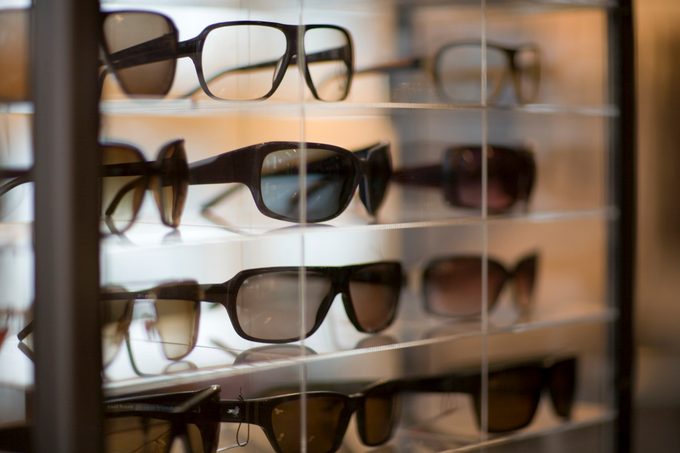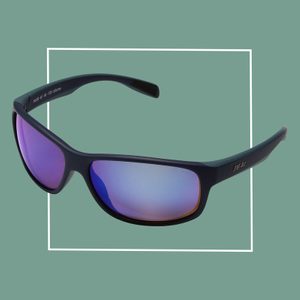What Does It Mean If Sunglasses Are Polarized?
Updated: Oct. 07, 2021
What are polarized sunglasses? Are they right for you? Experts shed light on these special shades, and offer some tips on how to pick out a pair.
Shedding light on popular eyewear
Sunglasses do a lot more than make you look cool, including protecting your eyesight. Case in point: polarized sunglasses. This type of eyewear reduces the impact of glare and eases eye strain. Let’s take a look at their pros and cons so you can decide if they’re right for you.
What is polarized light?
Sunlight that hits an uneven surface, like a tree or a rock, reflects back in all directions. But when that same light bounces off flat surfaces such as still water, snow, or a road, something different happens. The light tends to move more uniformly rather than scattering all over the place, and it comes at you horizontally or vertically. This is polarized light, which we experience as glare, according to the American Academy of Ophthalmology.
It can be at best annoying and uncomfortable, and at worst blinding. When you’re behind the wheel of a car, that can be dangerous. This is where polarized sunglasses come in handy.
“Polarized lenses give you more ease and less eye strain in a given environment when there’s a lot of light,” says optometrist Michelle Battaglia-Capogna, OD, of Northwell Health Ophthalmology in Great Neck, New York.
(Please don’t fall for any of these 10 sunglasses myths, which could ruin your eyes.)

What do polarized sunglasses do?
Application of a chemical coating to your lenses creates a filter that blocks much of the polarized light responsible for glare. Dr. Battaglia-Capogna offers an example to explain:
“If you’re looking at water as sunlight bounces upwards off of its surface,” she says, “the glare of the light that’s passing in a vertical direction will be allowed to enter your lens while anything moving in a horizontal fashion will be blocked.”
And there’s more: “In addition to reducing glare, polarized lenses enhance contrast for most people,” says Mark Fromer, MD, an ophthalmologist at Lenox Hill Hospital in New York City.
Contrast sensitivity is your ability to distinguish objects from one another and from the background. By reducing glare, polarized lenses can enable you to more easily pick out details. The result is a clearer, darker view that’s easier on your eyes.
When do polarized sunglasses provide the most benefits?
Glare can be troublesome in many circumstances, but the most common situations when you will experience it include daytime driving, skiing, boating, and fishing, says Dr. Battaglia-Capogna.
“There are so many situations on a daily basis that such lenses can help with,” she says.
When you’re on the water, for example, glare makes things more difficult to see. Put on a pair of polarized glasses, though, and another world opens up for you.
“Fun fact: polarized lenses allow you to see into the water so you can actually see fish, which can be helpful or just fun,” says Dr. Battaglia-Capogna. “They also help prevent eye strain when you’re on the water and surrounded by glare.”
Polarized sunglasses also may be helpful if you have impaired vision due to glaucoma, diabetic eye disease, or retinitis pigmentosa, says Dr. Battaglia-Capogna.
“Reducing glare and maximizing contrast is important for people who have subpar vision,” she says.
If you have trouble adapting from light to dark, say when entering a movie theater, polarized glasses can help ease that transition, says Dr. Battaglia-Capogna. “This is especially true if you have vision impairment that makes it difficult to adapt to changes in light.”
(Here are the best sunglasses for your face shape.)
When should you not wear polarized sunglasses?
Helpful as they can be, polarized sunglasses are not meant for every situation. For example, Dr. Fromer advises against wearing them at night. While they may reduce the glare of oncoming headlights, they also make a dark scene even darker. That could make it harder to see than the glare does.
In winter, you want to consider road conditions before you put on your polarized sunglasses. Why? Because it may be harder to see ice on the road.
“You’re not going to see that reflective glare coming off the ice,” Dr. Battaglia-Capogna. “They’re definitely beneficial to wear while driving, but keep in mind when it’s icy out because you may not realize that there may be ice.”
When wearing polarized sunglasses, you may have trouble with LCD (liquid crystal display) screens that are commonly used for computer monitors, cell phones, ATMs, and more.
What should you look for when buying polarized sunglasses?

Polarized sunglasses come in more than one color. For example, gray is better for bright, sunny, hazy conditions, while amber lenses work well on cloudy, overcast days, says Dr. Battaglia-Capogna. Your eye doctor or optician can help you decide what’s best for you. Need help picking out a pair? Click here.
Make sure to confirm that the polarized sunglasses you purchase also protect against the sun’s ultraviolet rays, both UV-A and UV-B light. Here are some of the best UV-blocking sunglasses.
“It’s always important to look at the labeling of what you’ve got,” says Dr. Battaglia-Capogna. “Make sure there’s a sticker that says it blocks UV light.”
Next, keep in mind these 7 tips for extending the life of your eyewear.



